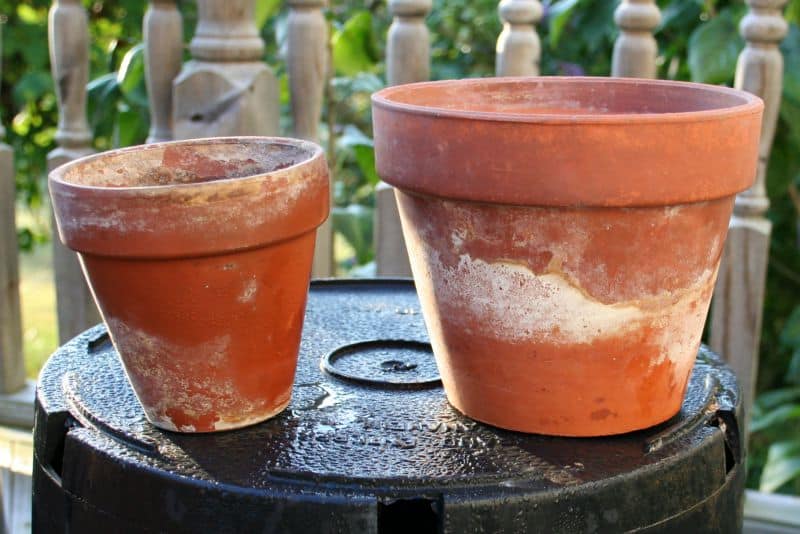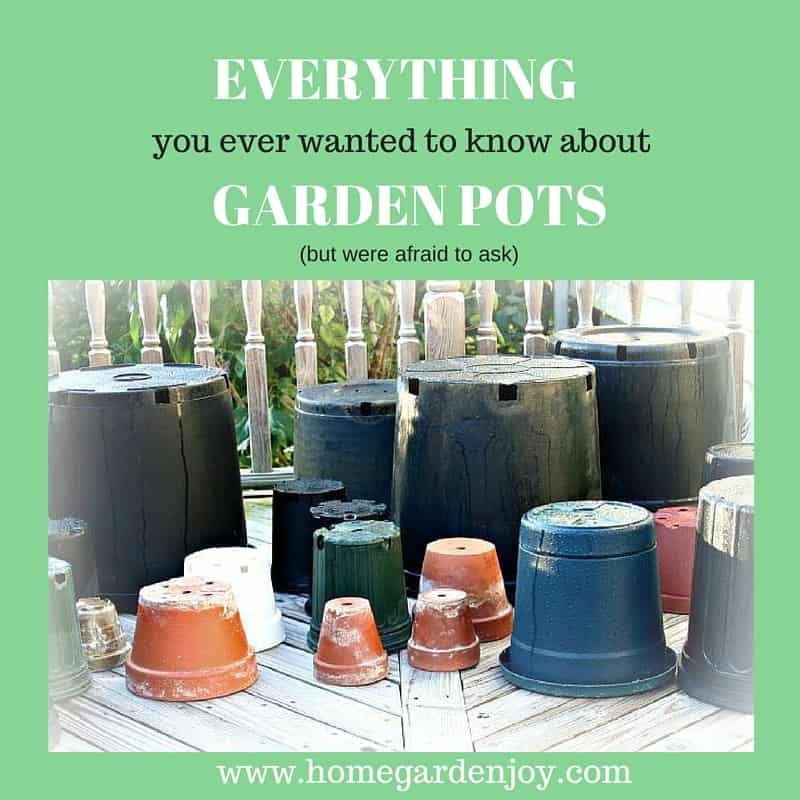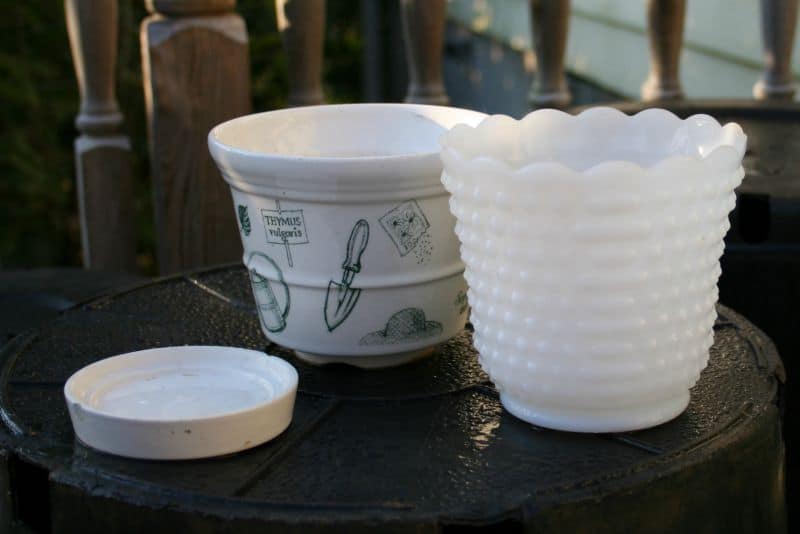I was writing about garden pots in an article, casually using phrases like “make sure there’s good drainage” and “make sure the pot is slightly larger than the root ball” and I realized, “What if people don’t know what makes a great garden pot?” This series on types of garden pots, and the pros and cons of each, should answer all your questions about choosing garden pots and containers…without making new gardeners feel dumb!
Types of Garden Pots
Walk into any nursery and garden center and you’ll be faced with myriad choices of garden pots. Colorful, decorated ceramic pots, big plastic pots, formed resin garden containers, clay and stone pots…which should you choose? Is your choice based solely on aesthetics, or is there some benefit to the plants by choosing, say, a clay pot versus a plastic pot?
In this series of articles, I’ll share with you the different types of pots, containers and more in which to grow plants. I’ll help you understand the differences between each, and why one might be better than another. I’ll walk you through the pitfalls of certain pots, and how to use what you may already have in your shed or garage. Lastly, I’m happy to answer any questions you may have about garden pots and garden containers, so drop me a note in the comment box under a post to ask a question. Check back for the answers, which will be left as replies to comments.
Garden Pots and Containers
This weekend, my husband needed to go into the crawl space under our house to fix a wire for the television antenna. He found a whole stash of garden pots and containers I’d forgotten I had. Boy, was I embarrassed!
We went through the pots, throwing out some and keeping others. I washed the remaining garden pots to put away in the shed so that I can find them more easily. As I tossed aside some of them, my husband asked, “Why are you throwing that one away?”
I spoke without thinking, talking about poor drainage holes, flimsy construction, and more. It was only after I returned to my office and began writing an article in which I casually mentioned which garden pots to select that I realized I took it for granted that new gardeners and casual hobby gardeners know their way around the various containers and pots available to the gardeners.
There are four general types of garden pots or containers available to purchase:
- Plastic garden pots are the most common type of container for plants. Many plants are sold in plastic containers, but you can also buy them separately when transplanting your house plants. They’re economical, easy to clean, and usually rather plain.
- Resin pots are made from a heavier plastic. Many are molded with fanciful designs or using resins with colors and textures added to mimic stone.
- Clay pots are made of porous red clay or terracotta. They are heavier, have a drainage hole in the bottom, and are quite heavy. Clay pots are typically used for plants that like it dry (think cacti).
- Cachepots are decorative pots or containers. They are usually made of ceramic, but can also be made from metal or plastic.

These are clay pots. The white crud on the outside comes from mineral deposits in the water that stick to the porous clay…it won’t hurt your plants.
Of course there are more types of garden pots and containers available, but these are the four that you’ll see most often at your local “big box” store or garden center, and the four that most gardeners end up with in their collection.
Over the next several days, I’ll add more specifics on each type of pot or container. This should help you choose the best one for your plants. In the meantime, happy gardening!








I bought some gorgeous Argyranthemums (small Daisy-like flowers-the size of a thumb print), that range from light yellow through a medium yellow and most flowers range from yellow through various ranges of pink) I intended to keep them in pots (so trimming of dead flowers is easily done as the pots can be lifted & easily turned in your lap while deadheading to encourage continuous flowering. I got saucers to keep ants & slugs away from entering the soil & damaging roots.
Over the 5 weeks I’ve had them, I’ve had to water them daily to keep them from wilting! They were purchased in a somewhat flexible plastic pot that is 6″ at the rim by 4″ deep. I pulled a sampling of the 9 plants from their pots to see what was going on. I wanted to use them in containers as a border in a flower bed around my front porch . Roots surrounded the edges (but you still see more than 50% soil along with the roots at the posts side edges), but were not yet visible, nor going through the several drainage holes at the bottom of their original container. I want to keep the plants that are currently 6″ tall by 9″ wide within 12″ all around as a border. Since the plants had obviously outgrown the sides of the container they came in, and I could not find a plastic pot that wasn’t way too big, I got unglazed terra cotta clay pots that are 7″x7″. I thought this the perfect size with 1″ more in width and almost 3 more in depth. Then after reading your posts about pot comparisons, I am wondering if a clay pot would defeat the purpose of being able to go a week without wilting (since you say the clay can pull moisture out of the pot. I live in Southern CA near Disneyland, and temps haven’t even gotten into the 80’s yet most days. In July thru October we will experience 90 degrees and even 3 digit weather, and watering more than once a week doesn’t really work for me!
WHAT TO DO? I suppose I could mix 1/2 well draining potting soil, with another half of regular bagged soil that isn’t labeled that it drains well for potted plants . . . , so the plants retain some moisture without rotting roots by retaining too much water. I also thought I could line the sides of the pots with sphagnum moss, or those light brown hanging pot material that is kind-of woven into shape. I also thought I could glaze the outside of the pot by painting it with some textured paint (or would it be better to use clear spray paint to seal the insides of the pots (or paint on some kind of varnish sealer–inside & or outside?) to help the well draining potting mix I bought from allowing the clay to pull moisture out of the soil & continuing to demand watering several times a week! Not only don’t I have the time to water so often, but if I go away for a weekend, I would come home to dead plants . Or maybe I should paint the insides with that black prunning sealer?
Any warnings or suggestions would be greatly appreciated.
Thank YOU so very much for your thoughts and TIME 🙂
Thanks so much for writing and providing plenty of information – it really helps me understand what’s going on! First, Argyranthemums are cool season annuals. It may already be getting too warm for its liking. It sounds like that may be part of the issue. If you want to use clay pots or decorative ceramic pots, my suggestion is to keep the plants in plastic pots but slip the entire plant, pot and all, inside the ceramic container. This will do several things. First, it will give you a prettier pot so it will look nice on the deck. Second, it will keep water inside the ceramic pot to water from the bottom which should prevent the wilting. I do this on our front porch and it works well. I’ve included a picture of the pots on the porch. Every single one, including the green one, actually has a plant in another pot inside it. The planters keep the water near the bottom so the soil soaks it up during the day I do think clay pots would be too porous for these plants especially in southern CA. Good luck and let me know how it works out!
